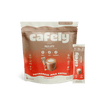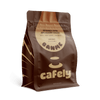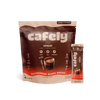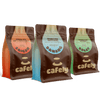If you’re just getting into coffee, you’ve probably quickly realized there’s a whole glossary of espresso-based drinks out there — macchiato, ristretto, flat white… and then there’s lungo. What is this popular Italian beverage, and how can I make it at home?
In this guide, you'll learn everything you need to know about lungo coffee, its qualities, and how to make it. You’ll also learn about five other espresso-based beverages that are similar to the lungo.
What is Lungo Coffee?
A lungo — meaning “long” in Italian — is an espresso made with best coffee selections by pulling a shot for a longer period. This results in a beverage with more volume, meaning more water.
Lungo coffee tastes milder than brewing a regular espresso but can still be bitter due to the longer extraction time. This brew can be compared to Americano coffee — espresso that's diluted with hot water. However, rather than adding water after the brewing process, it's passed through the coffee grounds during extraction. The lungo also typically has a smaller serving size than Americano coffee and a much more intense flavor profile.
Where is Lungo Coffee From?
Lungo coffee originates from Italy. The lungo is a staple in Italian coffee culture, often enjoyed as an alternative to espresso. It’s perfect if you want a bold but less intense brew that you can sip and enjoy more slowly.
Like many other Italian espresso beverages, lungo is usually made with 100% Arabica beans or an Arabica-rich blend. Most Italian cafes prefer medium roasts for lungo coffee, as they produce balanced flavors, some sweetness, and mild bitterness.
What Do You Need to Make Lungo Coffee?

Making a lungo is simple and requires few ingredients. However, you will need an espresso machine to make this coffee.
Here’s what you’ll need to make lungo coffee:
Ingredients
- High-Quality Coffee — Opt for a high-quality, medium-roast whole-bean coffee.
- Water — Use fresh, filtered water. This results in a cleaner-tasting cup and looks after your espresso machine.
- Sugar (Optional) — Add a spoonful of sugar after brewing to sweeten your lungo if desired.
Equipment
- Espresso Machine — You’ll need an espresso machine or a stovetop brewer such as the moka pot.
- Coffee Grinder — If your espresso machine doesn't have a built-in grinder, you'll need a separate burr coffee grinder to produce fine grounds.
- Coffee Measure — A coffee measure or weighing scale will help you accurately achieve the perfect coffee-to-water ratio for making a lungo.
- Tamper — A tamper is needed to pick the ground coffee into the portafilter for your espresso machine.
- Small Coffee Cup — Use a small coffee cup or your favorite mug to pull the lungo into.
Coffee Recommendations
The best coffee for making lungo should be high-quality and freshly ground. Sourcing freshly roasted whole-bean coffee and grinding it just before brewing results in a clean, bold, complex brew. If you must opt for a pre-ground coffee, make sure it’s from a reputable brand and has been ground recently.
The type of coffee you use to make lungo coffee is up to you. Traditionally, this beverage is made with 100% arabica coffee or a balanced blend of robusta and arabica. You can also make lungo coffee with 100% robusta coffee, but the brew may be overly bitter for some people.
Here are the qualities of each coffee type when used to make lungo:
- 100% Arabica — Arabica coffee such as Cafely DaLat produces a naturally sweet, smooth brew with a mild caffeine hit.
- Arabica and Robusta Blends — Blends like Saigon OG produce a velvety, dark lungo with a balance of sweetness and bitterness. Blends tend to be stronger than 100% arabica coffee.
- 100% Robusta — Robusta coffee, such as HaNoi or BanMe, produces a chocolaty, bitter lungo with little natural sweetness. Robusta lungo is an acquired taste but contains around twice as much caffeine as arabica lungo.
How to Make Lungo Coffee: Step-by-Step Guide
Making lungo coffee is simple. Here’s a step-by-step guide to making lungo coffee:
1. Prepare Your Espresso Machine

First, you'll need to prepare your espresso machine by turning it on and filling the reservoir with clean, fresh, filtered water. Most espresso machines take 10 to 30 minutes to heat up fully.
Once your machine has fully heated up, place a cup under the portafilter and purge the system. Discard the water from the cup and place it back on the drip tray.
2. Measure and Grind Your Coffee

Next, measure and grind your coffee. You'll need to produce a grind similar in consistency to powdered sugar (fine grind size). Use the built-in grinder on your espresso machine or a burr grinder.
You’ll need around 9 g of coffee per 4 oz (120 mL) serving.
3. Prepare the Portafilter

Add your ground coffee to your portafilter and distribute it evenly. Tamp the grounds with firm, even pressure, but avoid pressing down too hard — that can lead to channeling and over-extraction.
4. Brew the Lungo

Lock your loaded portafilter into the group head of your espresso machine. Begin extracting a shot as you normally do, running the water through the grinds for 50 to 70 seconds. The longer you pull the espresso, the milder but more bitter the lungo will be.
5. Assess Your Coffee

Once you've pulled your lungo, assess its quality. It should have a dark, rich body and a light caramel-colored crema.
The brew should not be overly strong or overly weak, nor should it be too bitter. If you find your lungo too weak and bitter, reduce the extraction time slightly. If it tastes too strong, increase the extraction time slightly.
6. Enjoy Your Lungo

Once you're happy with the quality of your lungo coffee, sweeten it with a spoonful of sugar if desired and sip slowly to enjoy.
Similar Espresso-Based Brews to the Lungo
The lungo isn't the only espresso-based brew out there. Several other drinks from Italy and other famous coffee countries across the globe produce similar-tasting brews made through pressurized extraction.
Here are five similar coffees to the lungo and how to make them:
1. Espresso
Espresso coffee is a thick, dark shot of coffee served in small demitasse cups. This brew uses the same amount of coffee as a lungo but much less water. A shorter extraction time results in a smooth, concentrated shot of coffee with a rich, caramel-like crema on top.
Here’s a quick guide on how to make espresso:
- Warm up the espresso machine and fill the reservoir with filtered water.
- Measure out 9 g of coffee for a single shot or 18 g for a double shot.
- Grind the coffee finely.
- Fill the portafilter with the ground coffee and apply even, firm pressure with your tamper to pack it.
- Lock the portafilter into the group head of your espresso machine and place a small demitasse cup underneath.
- Start pulling the shot and time the extraction — aim for 25 to 30 seconds.
- Your shot should be dark, rich, and not overly bitter, with a caramel-colored crema on top.
2. Ristretto
A ristretto is a concentrated espresso that is “restricted” during brewing. It uses the same amount of coffee as an espresso shot but is pulled for less time, creating a strong, highly caffeinated shot with less volume.
Making a ristretto is similar to making an espresso. The same steps are required, but the shot is only pulled for 15 to 20 seconds rather than 25 to 30 seconds.
Here’s a simple guide on making ristretto coffee:
- Heat the espresso machine and fill it with water.
- Measure and grind 9 g of coffee to a fine consistency.
- Fill and tamp the portafilter.
- Lock the portafilter into the group head of your machine and place a small cup on the drip tray.
- Pull the shot and time the extraction for 15 to 20 seconds.
- Enjoy your ristretto.
3. Macchiato
The macchiato coffee is an espresso coffee with a dash of milk. In English, the word macchiato means “stained,” referring to how the espresso shot is lightly marked with steamed milk.
Adding a touch of milk to an espresso shot removes a bit of the bitterness, making it more palatable. You still get the intensity and flavors of the coffee but with a touch of creaminess from the dairy.
Here’s how to make a macchiato coffee:
- Prepare your espresso machine by heating it and filling the water reservoir.
- Measure 18 g of high-quality whole-bean coffee and grind it fine.
- Fill the portafilter with the ground coffee and firmly tamp it using your tamper.
- Lock the portafilter into the group head and place a small cup on the drip tray below.
- Brew the shot and time the extraction for 25 to 30 seconds.
- Steam a small amount of milk (one or two tablespoons) using a milk pitcher and the steam wand on your espresso machine. You want to create a fine, velvety microfoam.
- Gently add a spoonful of microfoam to your espresso, making sure the milk floats on the top.
- Enjoy your macchiato without stirring.
4. Latte
Café latte is one of the most popular coffee beverages in the United States. It combines espresso coffee with steamed milk to create a rich, creamy beverage with a mild to strong caffeine hit. It has a light, velvety texture and is typically served in six to eight-ounce cups.
Here’s how to make a latte coffee:
- Prepare your espresso machine by heating it and filling the water reservoir with clean, filtered water.
- Measure and grind your coffee to a fine consistency. Use 18 g for a double-shot latte or 9 g for a single.
- Fill the portafilter, tamp the grounds, and lock it into the group head on your machine.
- Pull an espresso shot into a small cup or pitcher. Time the extraction for 25 to 30 seconds.
- Add around six ounces of whole milk (or a high-protein vegan alternative) to a milk pitcher.
- Steam the milk until a light, airy, microfoam is produced.
- Assemble the brew by pouring the espresso shot into a large coffee cup, followed by the steamed milk. Hold back the foam with the back of a spoon, and gently pour this last so the fine foam remains intact on the top of your brew.
5. Cortadito
The cortadito coffee is often called the “Cuban latte.” This beverage is made with a 1:1 ratio of espresso-like coffee made with a moka pot and steamed milk. It’s served with “espuma” — a sweet coffee foam that sits on top of the beverage.
This Cuban coffee is a mellow brew that’s strong and sweet. Like the lungo, it’s milder than a straight espresso shot but provides the same caffeine content.
Here’s how to make a cortadito:
- Measure out six to 20 g of coffee, depending on the size of your moka pot. Grind it finely.
- Fill the bottom of your moka pot with water, then add the filter basket and pour in the ground coffee.
- Screw the collection chamber onto the bottom water reservoir.
- Place the pot on the stove over medium heat and wait for it to start “gurgling.” When you hear this, lower the heat.
- As the first drops of coffee come up through the spout in the collection chamber, gently use a spoon to remove around a teaspoon.
- Add two tablespoons of granulated white sugar to the teaspoon of coffee in a bowl. Whip the mixture until you produce a thick, sticky foam (espuma).
- Once your moka pot has finished brewing, pour the coffee into a regular-sized coffee cup.
- Use a steam wand (or a stovetop pan and milk frother) to create a light, velvety milk foam. You’ll need around the same amount of milk as the amount of coffee you brewed (usually 60 to 100 mL).
- Pour the steamed milk over the coffee and gently spoon the espuma on top.
- Enjoy your sweet, indulgent cortadito coffee while warm.
FAQs: Lungo Coffee
Want to learn more about lungo coffee and other similar brews?
Read through the frequently asked questions below.
1. What Does Lungo Coffee Taste Like?
Lungo coffee tastes like a mild espresso shot. It has a strong flavor but is more diluted, leading to a thinner brew that's much easier to drink. Although generally milder in terms of flavor, lungo coffee can taste more bitter than a regular espresso shot due to the longer brewing time, extracting more bitter compounds from the beans.
2. Is Lungo Different From Espresso?
Yes. Lungo is different from regular espresso, although it’s made in (more or less) the same way. The lungo uses the same amount of coffee as an espresso shot but is pulled for a longer period, making it more diluted.
3. How Much Caffeine Is in a Lungo Coffee?

The caffeine in a serving of lungo coffee varies depending on the type of coffee used. However, the average 130 mL serving of lungo coffee made with 100% arabica coffee contains between 70 and 110 mg of caffeine.
4. Can You Make a Latte With a Lungo?
Technically, yes. You can make a latte coffee with a lungo coffee. However, due to the shot's larger volume and dilution, the resulting latte may taste thin, less creamy, and less intense than a regular cup made with espresso.
5. What’s the Best Coffee for Making Lungo?
The best coffee for making lungo should be high-quality and freshly ground from whole beans. A traditional lungo is made from 100% arabica beans such as DaLat, but you can make a stronger brew with robusta and arabica blends like Saigon OG.
6. Can You Make Lungo With a Moka Pot?
It can be difficult to craft a lungo with a moka pot device because the filter basket and water container are designed for full-strength espresso coffee. However, it is possible if you add fewer coffee grinds to the filter.
7. What’s the Difference Between a Lungo and Ristretto?
A lungo is an espresso that's pulled for a longer time with a larger volume of water. The lungo is essentially a diluted espresso. Ristretto is made by pulling an espresso shot for a shorter time. This results in a more concentrated shot with less volume.
8. Can You Make Lungo With Instant Coffee?
No, you can't make a “true” lungo with instant coffee. However, you can make a similar-tasting brew by diluting our Vietnamese Instant Espresso coffee.
9. What Grind Size Should I Use to Make Lungo Coffee?
The lungo is made using an espresso machine and requires the same grind size you would use to pull a regular shot. A fine grind is required for making lungo coffee — similar in consistency to powdered sugar.
10. Can You Use Robusta to Make Espresso?
Yes, you can use 100% robusta beans or a blend with arabica coffee to make lungo coffee. However, robusta beans will produce a much stronger coffee with more bitterness — traits that may not appeal to people who want to drink lungo.










